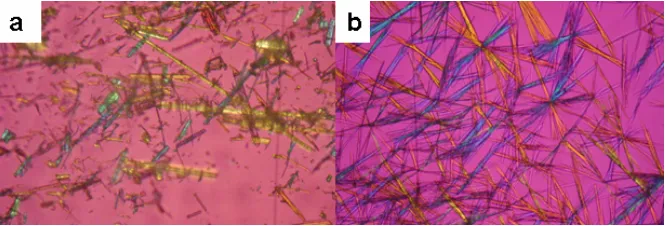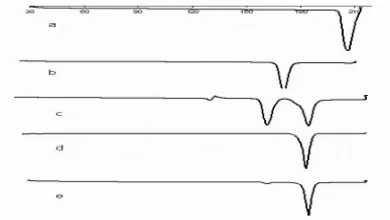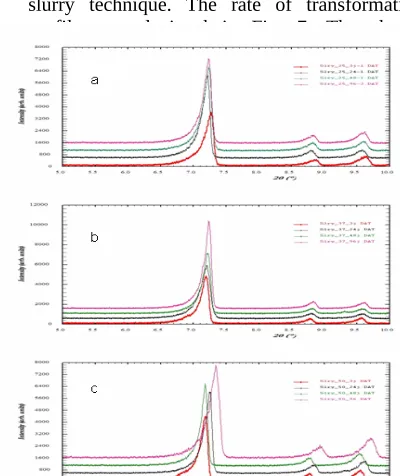ARTIKEL ILMIAH PENELITIAN HIBAH BERSAING 2009
Transformation of Cocrystalline Phase in Binary Mixture of
Trimethoprim and Sulfamethoxazole by Slurry Technique
Erizal Zaini
1*, Yeyet C. Sumirtapura
1, Sundani N. Soewandhi
1, Auzal Halim
2,
Hidehiro UEKUSA3 and Kotaro Fujii31School of Pharmacy Institut Teknologi Bandung, Jl. Ganesha 10 Indonesia 2Faculty of Pharmacy, Universitas Andalas, Limau Manis, Indonesia
3Department of Chemistry and Materials Science, Tokyo Institute of Technology
Ookayama 2, Meguro-ku, Tokyo 152-8551
*to whom corresponding should be addressd (e-mail: [email protected]), Tel : +6281395029297 ABSTRACT
The purpose of this work was to characterize and investigate the transformation of cocrystalline phase in binary mixture of trimethoprim and sulfamethoxazole induced by slurry technique and to establish the rate of transformation at various temperatures. Cocrystallization was performed simply by adding distilled water as solvent to equimolar binary mixture of powder trimethoprim and sulfamethoxazole. A new solid phase was characterized by thermomicroscopy, scanning electron microscope, powder X-ray diffraction, differential scanning calorimetry. The rate of transformation in slurry was studied as function of storage temperature, measured by powder X-ray diffractometry.Physical characterization showed that the trimethoprim and sulfamethoxazole cocrystalline phase had a unique thermal, powder X-ray diffraction property. Cocrystals prepared by slurry technique were similar in PXRD pattern to those prepared by solvent methods. The transformation to cocrystalline phase was accelerated by increasing the temperature of storage. It could be concluded that slurry could be carried out to induce a new equimolar cocrystalline phase between sulfamethoxazole and trimethoprim. The rate of transformation to cocrystalline phase was affected by the temperature of storage.
Keywords: Trimethoprim; sulfamethoxazole; cocrystalline phase; slurry technique and rate of transformation.
Introduction
It is well-known that pharmaceutical dosage forms containing multiple components can undergo interactions between various components or excipients that may lead to the physical and chemical change of certain constituents. In general, solid state or physical interaction beetwen two active solid ingredient or/and excipient could be classified as simple eutectics, solid solution and cocrystal (molecular compounds) (Davis et al, 2004). This kind of interactions can cause difficulties in manufacturing process and lower the quality of final dosage form (Zalac et al, 1999). On the other hand, the interaction could be positive effect on physicochemical properties and performance of solid active ingredients. For example, interaction of some polymer with
poorly soluble drugs in solid solution formation could enhance dissolution rate of drug and bioavailability (Leuner and Dressman, 2000).
Cocrystal formation has gained recent
interest in application to
complementary hydrogen bonding between the two components (Mc. Namara et al, 2006). Pharmaceutical cocrystal could be prepared by several methods. At present, preparation of cocrystal is mainly achieved by solution cocrystallization approach such as solvent evaporation, antisolvent addition etc. Additionally, crystallization from the melt, solid state grinding and sealed heating has been employed (Soewandhi, 1999; Erizal et al, 2008a; 2008b). mixture of trimethoprim and sulfamethoxazole induced by slurry technique and to establish the rate of transformation at various temperatures
.
Materials and Methods
Trimethoprim (TMP) and sulfamethoxazole (SMZ) was kindly obtained from P.T Pyridam equimolar ratio in glass vial by using a vortex mixer during five minutes. Cocrystal TMP-SMZ was prepared by solvent method. TMP (0.725 g)
and SMZ (0.633 g) equimolar were dissolved in small amount of methanol at ambient temperature. The solution was slowly evaporated at room temperature during 48 hours to promote cocrystallization.
Transformation studies
The rate of transformation under three storage conditions was evaluated as follows. The equimolar physical mixture TMP and SMZ (0.725 and 0.633 g respectively) were suspended in 40 mL of distilled water. They were stored at 25, 37 and 50 0C in a constant temperature water
bath (GFL) at a shaking speed of 75 rpm. Samples were withdrawn at suitable time
intervals and then immediately filtered under vacuum and dried at room temperature during 24 hours.
Hot-stage
polarized
optical
microscopy
Microphoto of slurry product and cocrystal from solvent method were performed by Olympus BX5 polarizing optical microscope equipped with hot stage and camera (DSC-05 Sony Inc. Japan). Preliminary analysis of melting point of cocrystal phase was obtained using hot stage at heating rate at 2 0C/ min.
Scanning electron microscopy
Electron-micrographs of crystal habit of cocrystalline phase were examined using SEM (JEOL model JSM-6360LA, Tokyo, Japan). The specimen were mounted on a metal stub with double sided adhesive tape and coated under vaccum with gold-paladium ( Au 80% and Pd 20%) prior to observation.
Differential scanning calorimetry
DSC analysis of approximately 1-4 mg samples in pin-holed aluminium crimped pans was performed using Rigaku ThermoPlus DSC Instrument (Japan), at heating rate of 10 0C per
min over a temperature range 30-200 0C.
Samples were purged with nitrogen gas at 60 mL/ min throughout the analysis.
Powder X-ray diffraction analysis
was prepared by solvent method (Erizal et al, 2008a). The total mass of each standard was 0.5 g. The standards prepared had 0, 10, 30, 50, 70, 90 and 100 per cent (by weight) TMP-SMZ cocrystal. The calibration curve for quantification of the percentage of cocrystalline phase was established based on the integrated
intensity of the characteristic interference of diffraction peaks in range 5-100 (2θ), which were
normalized against the percentage of cocrystalline in binary mixture.
Results and Discussion
Microscopic Analysis by Hot Stage Polarization and Electron Microscope
This analysis provided a preliminary characterization of cocrystalline phase in binary mixture of TMP-SMZ. Optical and electron microphoto was shown in Fig. 1 and 2. TMP-SMZ cocrystal from solvent method was needle
DSC Analysis
DSC Analysis was performed to characterize the thermal behaviour of TMP-SMZ cocrystalline phase in relation to the intact component and physical mixture of binary system. DSC thermograms for trimethoprim, sulfamethoxazole,
Fig. 1. Optical microphoto crystal habit a) powder sample after slurry technique and b) cocrystal by solvent method (methanol). Magnification 200x
shaped habit and was obtained wihin two days. Cocrystallization by slurry technique also yielded a same habit with cocrystal from solvent method, but still occurred a physical mixture of TMP and SMZ. A sharp melting point at around 180 0C was observed for the
TMP-SMZ cocrystal. On the other hand, the sample from slurry technique had two range melting point at around 156-160 0C and 178-182.4 0C.
Physical mixtures, cocrystal from solvent and slurry technique are presented in Fig. 3. Trimethoprim and sulfamethoxazole showed a single endothermic peak at 174.19 and 206
0C respectively. TMP-SMZ cocrystal from solvent method showed only one endothermic peak at 182.22 ºC indicated the formation of new crystalline phase of cocrystal between sulfamethoxazole and trimethoprim. A single endothermic peak for cocrystal also indicated the absence of any bound solvent (solvate) or water
in lattice crystal. The TMP-SMZ physical mixture showed three endothermic peaks at 131.20; 161.67 0C attributable to fusion of eutectic mixture and at 182.75 ºC due to fusion of cocrystal. The exothermic peaks at 140 ºC were attributed to recrystallization of mixture from melting. The results of DSC analysis matched with determination of melting point by hot stage microscope polarization, cocrystal from slurry technique had two endothermic peaks at 161.24 and 181.94 ºC. The area (enthalpy) of endothermic peak at 161.24 ºC was progressively decreased that indicating solid state transformation during slurry of binary mixture of TMP and SMZ.
Fig.3. DSC thermogram a) Intact trimethoprim,
b) Intact sulfamethoxazole, c) physical mixture of trimethoprim and sulfamethoxazole, d) cocrystal from solvent method and e) cocrystal from slurry technique.
Powder X-ray diffraction analysis
PXRD was a powerful method for the characterization of formation of a new crystalline phase in solid state. The diffraction pattern of cocrystal should be clearly distinct from that of the superimposition of each of the compound If a true cocrystal has been formed beetwen two solid phases. PXRD pattern of each of cocrystal formers were exihibit a crystalline solid (Fig. 4a-b). Those had been a characteristic interferences
peak at various diffraction angles (2 ). PXRDө pattern of trimetoprim-sulfamethoxazole PM (Fig 4c), all the characteristics interferences peak of trimethoprim and sulfamethoxazole were observed. A different PXRD pattern for cocrystal of trimethoprim and sulfamethoxazole (Fig. 4d) from those physical mixtures confirms the formation of a new cocrystal phase. The cocrystal had several characteristic interference peaks at 2θ = 7.32; 11.5; 16.90; 19.15 and 24.18. The PXRD of slurry product (Fig. 4e) showed interference peaks associated with trimethoprim and sulfamethoxazole decrease in intensity while new interference peaks appear. The cocrystalline phase formed by slurry technique exhibited identical powder XRD patterns to those grown from cocrystallization from methanol.
Fig. 4. PXRD patterns a) Intact trimethoprim, b) Intact sulfamethoxazole, c) physical mixture of trimethoprim and sulfamethoxazole, d) cocrystal from solvent method and e) cocrystal from slurry technique.
PXRD Calibration Curve
calibration curve was obtained (Fig. 5) by plotting the percentage of cocrystal against the integrated intensity of characteristic interference peak. WinPLOTR (version march 2007) sofware was used to determining the integrated intensity in PXRD patterns.
Fig. 5.Calibration curve of percentage cocrystal in binary mixture vs integrated intensity
Transformation Phase Studies
Transformation phase to cocrystalline phase in binary mixture of trimethoprim and sulfamethoxazole was performed by suspend the sample powder in 1:1 molar in distilled water and agitate at 75 rpm at various temperature 25, 37 and 50 0C. The sample was collected at
interval time 3, 24, 48 and 96 hours. The percentage of cocrystalline phase in slurry product increased with the prolongation of time storage as shown in Fig. 6 and 7. Intensity of interference peak at 2θ = 7.32 was also observed increased by elevation of temperature during slurry technique. The rate of transformation profile was depicted in Fig. 7. The slurry-mediated phase transformation was a complex process, due the fact that several mechanisms, such as dissolution of small amount particle, hetegeneous nucleation and then growth of new cocrystalline phase (Zhang et al, 2007 and Qu et al, 2006). The solid state transformation was highly temperature-dependent. The rate of many reactions increased about two to three time with each 10 0C rise in temperature (Ke et al., 2006
and Martin, 1993).
Fig.6. PXRD patterns of sample from slurry technique at different temperature a) 25 0C, b) 37 0C and c) 50 0C
Fig. 7. The rate of transformation profile in slurry experiment at various temperature
Conclusion
It could be concluded that slurry technique induced a new equimolar cocrystalline phase between sulfamethoxazole and trimethoprim. The rate of transformation to cocrystalline phase was significantly affected by the temperature of storage.
We wish to thank Prof. Dr. Katsuhide TERADA (Faculty of Pharmaceutical Sciences, Toho University, Japan) for the fruitful discussion during my visiting in his laboratory.
References
Basavoju, S., Bostrom, D., and Velaga, S.P., (2006), Pharmaceutical Cocrystal and Salts of Norfloxacin, Crystal Growth and Design, 6(12), 2699-2708.
Davis, R.E., Lorimer, K.A., Wilkowski, M.A., Rivers, J.H., (2004), Studies of Relationship in Cocrystal Systems, ACA Transactions, 39, 41-61.
Erizal, Z., Sumirtapura, Y.C., Soewandhi, S.N., and Halim, A., (2008), Formation of Cocrystal between Trimethoprim and Sulfamethoxazole by Solid State Grinding, Proceeding Asean Scientific Conference in Pharmaceutical Technology, USM Penang Malaysia.
Erizal, Z., Sumirtapura, Y.C., Soewandhi,
S.N., and Halim, A., (2008), Cocrystal Formation between Trimethoprim and Sulfamethoxazole by Sealed Heating Method, Acta Crystallography, A64, C490. Ke, X., Ping, Q., and Liao, Z., (2006), Interconversion Kinetic Studies of Betamethasone Acetate Polymorph in Water, Drug Dev. Ind. Pharm., (32) 1019-1024. Leuner., C and Dressman., J., (2000),
Improving Drug Solubility for Oral Delivery Using Solid Dispersions., Eur. J. Pharm. Biopharm., 50, 47-60.
Mc.Namara, D.P., Childs, S.L., Giordano, J., Larricio, A., Cassidy, J., Shet, M.S., Mannion, R., O’Donnell, E., and Park, A., (2006), Use of a Glutaric Acid Cocrystal to Improve Oral Bioavailibility of a Low Solubility API, Pharmaceutical Research, 23(4), 1888-1897.
Martin, A., (1993), Physical Pharmacy, Lea & Febiger Philadelphia London, 295-296. Qu, H., Louhi-Kultanen, M., Rantanen, J.,
and Kallas, J., (2006), Solvent-Mediated Phase Transformation Kinetics of an Anhydrate/Hydrate System, Crystal Growth and Design, 6(9), 2053-2060. Shiraki, K., Takata, N., Takano, R., Hayashi,
Y., and Terada, K., (2008), Dissolution Improvement and the mechanism of Improvement from Cocrystallization of Poorly Water-soluble Compounds, Pharmaceutical Research, 25 (11),2581-2592.
Soewandhi, S.N., (1999), Solid State Interaction
between Aprobarbital and
Isopropylantipyrine, Jurnal Matematika dan Sains, (Indonesian) 4(1), 20-31
Sun, C.C., and Hou, H., (2008), Improving Mechanical Properties of Caffeine and Methyl Gallate Crystal by Cocrystallization, Crystal Growth and Design, 8(5), 1575-1579.
Trask, A.V., Motherwell, W.D.S., and Jones, W., (2006), Physical Stability Enhancement of Theophylline via Cocrystallization, International Journal of Pharmaceutics, 320, 114-123.
Trask, A.V., and Jones, W., (2005), Crystal Engineering of Organic Cocrystals by The Solid State Grinding Approach, Top. Curr. Chem., 254, 41-70.
Zalac, S., Khan, M.Z., Gabelica, V., Tudja, M., Mestrovic, E., and Romih, M., (1999), Paracetamol-Propyphenazone Interaction and Formulation Difficulties Associated with Eutectic Formation in Combination Solid Dosage Forms, Chem. Pharm. Bull., 47(3) 302-307


